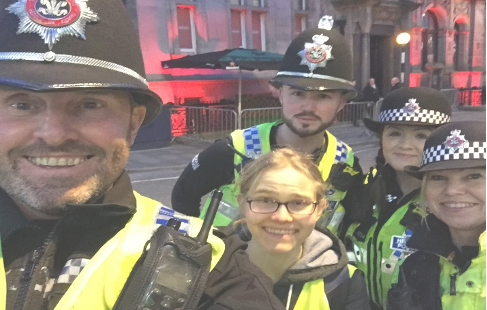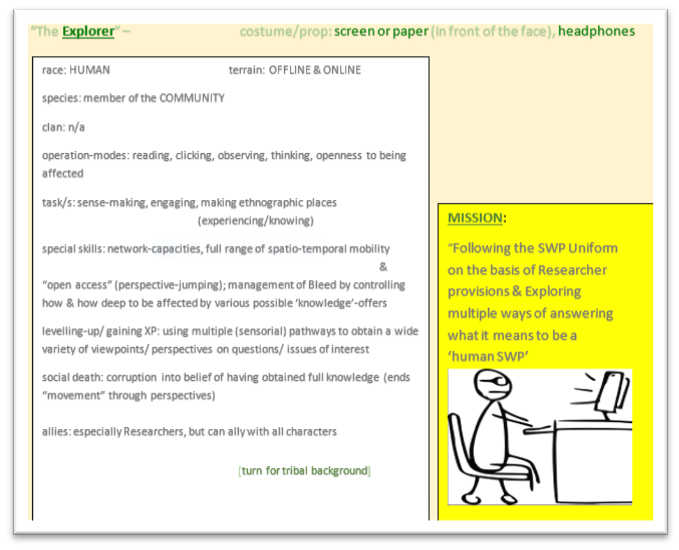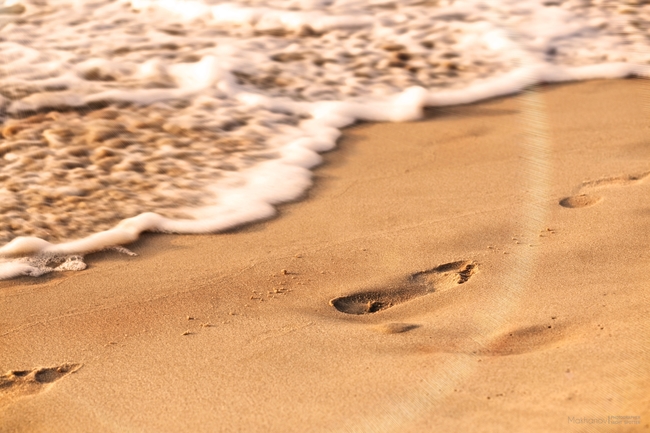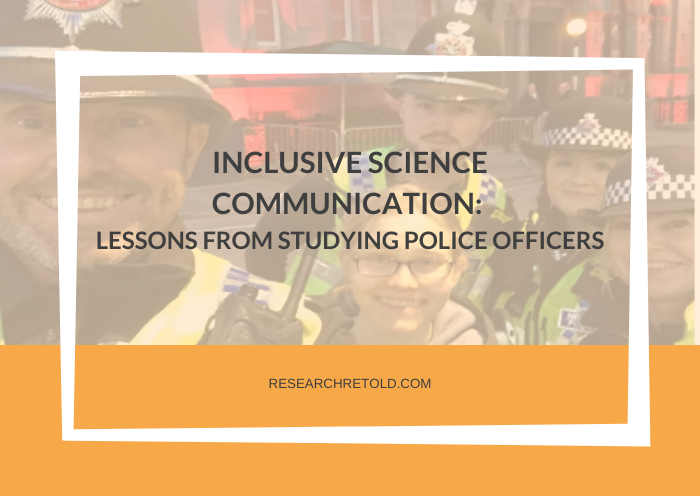In this post, Claire discusses lessons learnt during her studies about how to improve communication between groups using inclusive science communication.
Claire Förster recently finished her PhD at Swansea University. She used ethnographic methods to explore how emotions affect interactions between police officers and the public.
![]()
Inclusive science communication: Collaborating with South Wales Police officers
During my PhD studies, I wanted to understand what it meant to be both a professional police officer in the South Wales Police (SWP) and an ‘emotional human’.
To do this, I used ethnographic research methods, whereby I fully immersed myself in the SWP. I became part of their work-life and observed and interacted with the officers (can you spot the ‘odd one out’ in this on-duty selfie?)

I found that the SWP pursues several goals, including showing that they are doing their job well, i.e. “showcase good work” and being perceived as “one of the community”. Both involve “engaging with the public where [the public] spend most of their time”: in the streets of Swansea and on Twitter (@swpolice).
By taking selfies and posting “one Tweet a day”, police acted like “one of them” (the community) to build “trust” with civilians. By connecting with the public on an equal level, SWP could do their job to “inform, deter, educate” and generally “make people (feel) safe”.
This fascinated me because it echoes how ethnographers try and learn from those they engage with. My digital Sensory Ethnography largely hinged on me literally taking on a uniform and following officers on their shifts. Additionally, I ‘followed’ their Twitter activities.
Taking part in their work-life like this helped me learn what officers did on duty and try to understand why they acted in their ways. Thanks to the trusting relationships developed, the officers shared their insights with me so that I could learn and ideally pass on that learning to others.
What does inclusive science communication look like?
PhD candidates usually share their learning via a doctoral thesis. However, something that I heard during my work with SWP, resonated with me when thinking about how to share my research.
Police Twitter accounts were mostly followed by other police officers. Thus, as one officer put it: “police [are] talking to themselves”.
Similarly, “academics talk to themselves” by writing academic papers that are largely read by other academics.
I wanted to communicate my research differently to reach audiences beyond those used to reading academic work. In order to be understood by non-academics, I had to communicate more like them.
Therefore, I blogged about my work and addressed an even more varied ‘readership’ with my thesis which is a Live-Action Role-Play (LARP).
Without going into too much detail, LARP implied for instance giving the ‘role’ of an Explorer to my thesis’ readers. Below, you see a role card that my thesis featured alongside more standard elements like theory or a methods section.

How can I broaden my audience using inclusive science communication?
Consider these three questions.
1. What do you want to communicate and to what effect?
In my thesis, I shared the experiences of the police officers from their viewpoint as much as possible. Thus, I used many word-for-word quotes: “We are all human” and “vulnerable in our own ways” are both officers’ statements.
The way you write highlights what you find important about the content you communicate. It also needs to make sense to those who read your work.
As I wanted to write as accessibly as possible for a wide audience, I opted for a LARP format that invites ‘explorers’ to playfully co-experience researching SWP. Using this format turned learning into playing and helped to bring those who ‘explored’ my research in contact with the SWP and their experiences.
This communication style works for me because I am a playful, experimental researcher with a background in creative writing.
You, too, have a ‘style’ of communication. You just need to find and utilise it! Once you know what you want to say, think about how you could say it.
2. How to communicate depending on your audience?
I also shared my research in other ways depending on whom I was trying to connect with. Like SWP, I try to blend in because I could speak, more or less, the audience’s language.
No “one size fits all”: diversify your formats to ‘cater to the audience’
To that end, I translated the LARP insights into policy-informative advice papers (e.g. on the usefulness of Big Data analytics in resource allocation for police) that met the evidence needs of policymakers.
Moreover, to claim a place amongst researchers, I gave conference presentations and introduced draft articles. Those who, figuratively, ‘play’ the researcher role more commonly accept these formats.
3. How does your audience communicate and what are their priorities?
When sharing information, commercial stakeholders might think about scalability and marketability whilst a researcher might consider ethics and transparency.
When planning your research communication strategy consider what your audience is interested in. You could run a poll to do so. Thereby you make sure your audience is receptive to your content.
Once you identify your ‘target audience’, try taking their position.
My PhD’s methodology is called Sensory Ethnography (SE). One basic premise is that every ‘body’ knows through ‘experience’. Yet, everybody experiences the world differently, with varying perspectives and capacities to make sense.
An important part of SE is that learning and knowing are transformative, interactive processes between bodies, including humans, that change by engaging with each other. What you learn through your research changes you and those (worlds) you have researched. Whenever you reach out to ‘the world’ to communicate your learning, you are changing the world again and your position therein.

Water photo created by wirestock – www.freepik.com
Moreover, experience ‘emerges’ unpredictably so we cannot predict learning or knowing outcomes. However, by diversifying how you communicate you can establish connections with a variety of people, whom you change and whose knowing and learning you enable.
More open approaches to research dissemination could ensure a broader range of people are brought into the transformative learning experience that ‘research’ can facilitate.
Take-away points on achieving inclusive science communication:
- How you write expresses something about you and your values. This is important for the ‘messages’ you transmit and you should capitalise it e.g. in your formats or styles of address.
- Your audiences have specific ‘customs’ of making sense of their world, and agendas of interest. By blending in with how they communicate, you might better ‘sneak in’ what’s important for you to pass on.
- The more you experiment with the ‘how?’ of communicating your research, the more opportunities you give others to relate to it in different ways. Plus: you might express different aspects of your researcher-persona in the process, too!
Ideally, inclusive science communication turns a monologue into a never-ending, mutually engaging chat between “academia” and “the world” wherein all learn from each other.
Many thanks to Claire Forster for sharing her insights on inclusive science communication. You can find Claire on Twitter @ClaiResearch
